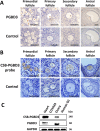CSB-PGBD3 Mutations Cause Premature Ovarian Failure
- PMID: 26218421
- PMCID: PMC4517778
- DOI: 10.1371/journal.pgen.1005419
CSB-PGBD3 Mutations Cause Premature Ovarian Failure
Abstract
Premature ovarian failure (POF) is a rare, heterogeneous disorder characterized by cessation of menstruation occurring before the age of 40 years. Genetic etiology is responsible for perhaps 25% of cases, but most cases are sporadic and unexplained. In this study, through whole exome sequencing in a non-consanguineous family having four affected members with POF and Sanger sequencing in 432 sporadic cases, we identified three novel mutations in the fusion gene CSB-PGBD3. Subsequently functional studies suggest that mutated CSB-PGBD3 fusion protein was impaired in response to DNA damage, as indicated by delayed or absent recruitment to damaged sites. Our data provide the first evidence that mutations in the CSB-PGBD3 fusion protein can cause human disease, even in the presence of functional CSB, thus potentially explaining conservation of the fusion protein for 43 My since marmoset. The localization of the CSB-PGBD3 fusion protein to UVA-induced nuclear DNA repair foci further suggests that the CSB-PGBD3 fusion protein, like many other proteins that can cause POF, modulates or participates in DNA repair.
Conflict of interest statement
The authors have declared that no competing interests exist.
Figures



Similar articles
-
The conserved Cockayne syndrome B-piggyBac fusion protein (CSB-PGBD3) affects DNA repair and induces both interferon-like and innate antiviral responses in CSB-null cells.DNA Repair (Amst). 2012 May 1;11(5):488-501. doi: 10.1016/j.dnarep.2012.02.004. Epub 2012 Apr 6. DNA Repair (Amst). 2012. PMID: 22483866 Free PMC article.
-
Tethering of the conserved piggyBac transposase fusion protein CSB-PGBD3 to chromosomal AP-1 proteins regulates expression of nearby genes in humans.PLoS Genet. 2012 Sep;8(9):e1002972. doi: 10.1371/journal.pgen.1002972. Epub 2012 Sep 27. PLoS Genet. 2012. PMID: 23028371 Free PMC article.
-
An abundant evolutionarily conserved CSB-PiggyBac fusion protein expressed in Cockayne syndrome.PLoS Genet. 2008 Mar 21;4(3):e1000031. doi: 10.1371/journal.pgen.1000031. PLoS Genet. 2008. PMID: 18369450 Free PMC article.
-
What role (if any) does the highly conserved CSB-PGBD3 fusion protein play in Cockayne syndrome?Mech Ageing Dev. 2013 May-Jun;134(5-6):225-33. doi: 10.1016/j.mad.2013.01.001. Epub 2013 Jan 28. Mech Ageing Dev. 2013. PMID: 23369858 Free PMC article. Review.
-
The role of Cockayne Syndrome group B (CSB) protein in base excision repair and aging.Mech Ageing Dev. 2008 Jul-Aug;129(7-8):441-8. doi: 10.1016/j.mad.2008.04.009. Epub 2008 Apr 30. Mech Ageing Dev. 2008. PMID: 18541289 Free PMC article. Review.
Cited by
-
Novel variants in women with premature ovarian function decline identified via whole-exome sequencing.J Assist Reprod Genet. 2020 Oct;37(10):2487-2502. doi: 10.1007/s10815-020-01919-y. Epub 2020 Aug 13. J Assist Reprod Genet. 2020. PMID: 32789750 Free PMC article.
-
Primary ovarian insufficiency: update on clinical and genetic findings.Front Endocrinol (Lausanne). 2024 Sep 26;15:1464803. doi: 10.3389/fendo.2024.1464803. eCollection 2024. Front Endocrinol (Lausanne). 2024. PMID: 39391877 Free PMC article. Review.
-
Primary ovarian insufficiency, meiosis and DNA repair.Biomed J. 2020 Apr;43(2):115-123. doi: 10.1016/j.bj.2020.03.005. Epub 2020 May 4. Biomed J. 2020. PMID: 32381463 Free PMC article. Review.
-
Premature Ovarian Insufficiency: Past, Present, and Future.Front Cell Dev Biol. 2021 May 10;9:672890. doi: 10.3389/fcell.2021.672890. eCollection 2021. Front Cell Dev Biol. 2021. PMID: 34041247 Free PMC article. Review.
-
A truncating MEIOB mutation responsible for familial primary ovarian insufficiency abolishes its interaction with its partner SPATA22 and their recruitment to DNA double-strand breaks.EBioMedicine. 2019 Apr;42:524-531. doi: 10.1016/j.ebiom.2019.03.075. Epub 2019 Apr 15. EBioMedicine. 2019. PMID: 31000419 Free PMC article.
References
-
- Van Kasteren YM, Hundscheid RD, Smits AP, Cremers FP, van Zonneveld P, et al. (1999) Familial idiopathic premature ovarian failure: an overrated and underestimated genetic disease? Hum Reprod 14: 2455–2459. - PubMed
-
- Wittenberger MD, Hagerman RJ, Sherman SL, McConkie-Rosell A, Welt CK, et al. (2007) The FMR1 premutation and reproduction. Fertil Steril 87: 456–465. - PubMed
-
- Dixit H, Rao LK, Padmalatha VV, Kanakavalli M, Deenadayal M, et al. (2006) Missense mutations in the BMP15 gene are associated with ovarian failure. Hum Genet 119: 408–415. - PubMed
Publication types
MeSH terms
Substances
LinkOut - more resources
Full Text Sources
Other Literature Sources
Medical
Molecular Biology Databases

